The California State University convened its inaugural biennial Juneteenth Symposium June 15-16, hosted by CSU Dominguez Hills, to celebrate African American history and achievement and promote and sustain the anti-racism work underway across the CSU's 23 campuses.
The hybrid in-person/virtual symposium featured keynotes from nationally renowned speakers including philosopher, author and activist Cornel West, Ph.D., California Secretary of State Shirley Weber, Ph.D., and San Diego State Vice President for Student Affairs and Campus Diversity/Chief Diversity Officer J. Luke Wood, Ph.D.
Breakout session topics included how to leverage CSU data to improve outcomes for Black students, the importance of innovative and culturally competent teaching and instruction and examining the trajectory of Black male students through an ethos of care, hope and healing.
In conjunction with the symposium, the university launched its CSU ACTs (Acknowledges, Commits and Transforms) initiative, which tasks campuses with developing a preliminary set of goals, measurable objectives and action steps to advance Black and African American student access and success.
“Beyond providing academic and co-curricular spaces for students to cultivate their intellectual potential, our roles in the CSU system are to prevent wings from breaking, and mend those that do," said CSUDH President Thomas Parham. “I encourage all of us to collectively provoke, instigate and inspire change; develop new, substantive programs that demonstrate our commitment to the true needs of students, staff, faculty and administrators of African descent; and examine and transform the policies and practices that inhibit rather than facilitate Black excellence."
Juneteenth marks the moment on June 19, 1865, when Union soldiers marched into Galveston, Texas, to free the last enslaved people of the state—more than two years after the Emancipation Proclamation was signed. It is recognized as a consequential day of reflection and is commemorated in communities across California and the nation.
CSU campuses have celebrated Juneteenth with performances, displays, lectures and more that recognize the history and achievements of Black students, faculty and staff, but the symposium marked the first time the university came together as a system to evoke systemic change.
The idea for the symposium came after national civil unrest shed light on the inequities that exist for Black and African American people in the United States. It was championed by Student Trustee Emerita Maryana Khames in March 2021 during her time serving on the Committee on Educational Policy and advanced by the full CSU Board of Trustees in May 2021.
“This is no time for complacency," CSU Chancellor Jolene Koester said during the symposium. “To improve the experience for Black students and faculty on CSU campuses, the university must aggregate the data, look at pedagogy in the classroom, talk about racism and examine policies and practices in place."
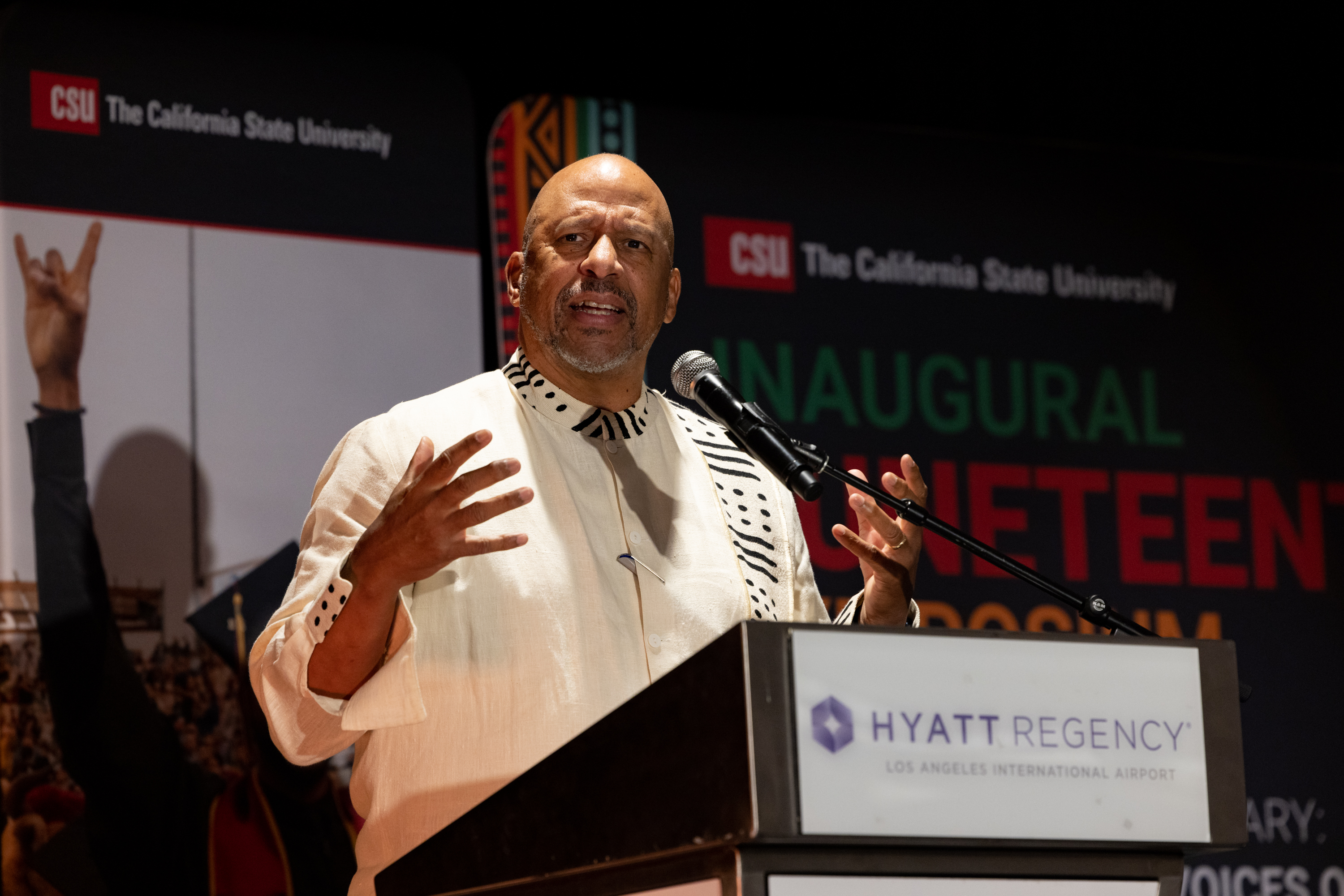
CSUDH President Thomas Parham urges symposium attendees to collectively provoke, instigate and inspire change.
Building on Prior Work
Black and African American students, faculty, staff and alumni have made and continue to make vast, meaningful and lasting contributions to the CSU and the state of California, but they continue to experience disproportionately greater inequities in college preparation, educational access and attainment.
As the nation's largest and most racially and ethnically diverse university, the CSU continues to promote the principles of inclusive excellence and embrace its role as a transformative institution that advances the upward mobility of millions of students and their families.
The CSU has made significant progress to increase graduation rates for all students while working to eliminate opportunity and achievement gaps through its Graduation Initiative 2025 (GI2025). In fall 2021, the university doubled down on eliminating equity gaps, announcing five equity goals to prioritize success for students, especially those from underserved communities and who have been historically underrepresented in higher education.
An integral effort to reach GI2025 goals is the CSU Certificate Program in Student Success Analytics, a professional development program that empowers faculty, staff and administrators to work collaboratively on understanding and addressing the factors that perpetuate equity gaps in higher education. The program fosters equity-minded and data-informed action to close equity gaps and support students on their way to a college degree.
The CSU serves more than 19,000 students who identify as Black or African American, and it awarded more than 4,300 undergraduate degrees and more than 800 graduate degrees to Black and African American students in 2020-21.
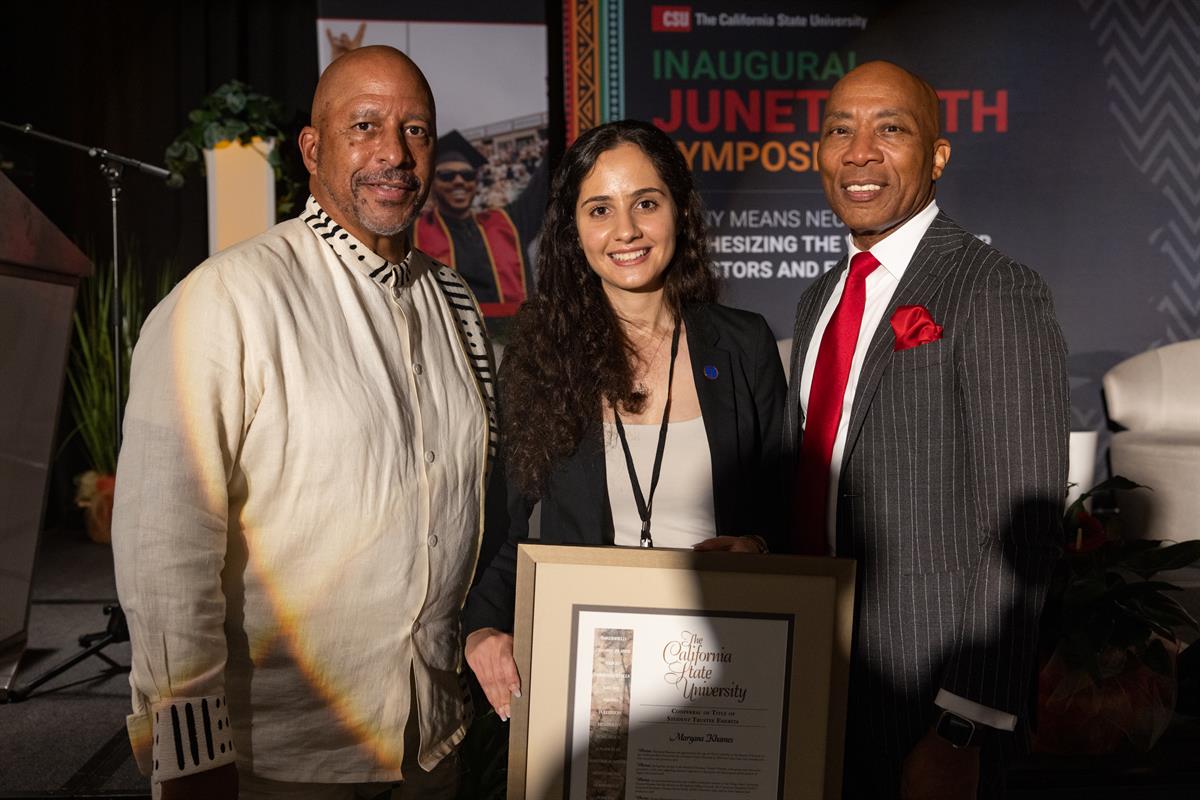
CSUDH President Thomas Parham, Student Trustee Emerita Maryana Khames and CSUDH Vice President for Student Affairs and Master of Ceremonies Dr. William Franklin, from left to right, pose with a framed copy of the resolution that established the symposium.
Increasing Enrollment and Belonging
CSU trustees recently voted to make amendments to Title 5 of the California Code of Regulations to remove SAT and ACT standardized tests from the undergraduate admissions process in a continued effort to level the playing field and provide greater access to a high-quality college degree.
Additionally, the CSU partners with churches, PK-12 schools, community organizations and non-profit organizations to increase preparation, enrollment and graduation rates for students from underserved communities through programs such as Super Sunday.
Once students are enrolled at the CSU, campuses provide a variety of culturally-specific resources to Black communities to increase students' sense of belonging and improve persistence rates. These resources are in addition to myriad cultural fraternities and sororities, clubs, living-learning communities and more.
CSU campuses also empower men of color through 'brotherhood' programs, which are funded in part by GI2025 and campus Student Success Fees. These programs place male students of color in cohorts as they go through its powerful mix of academic support, mentoring, community service and professional development.
In 2019, the CSU Young Males of Color Consortium launched a two-year plan designed to improve outcomes for men of color in the CSU. The plan was centered on four pillars intended to help build capacity among CSU campuses and improve programs designed to support the matriculation and development of men of color.
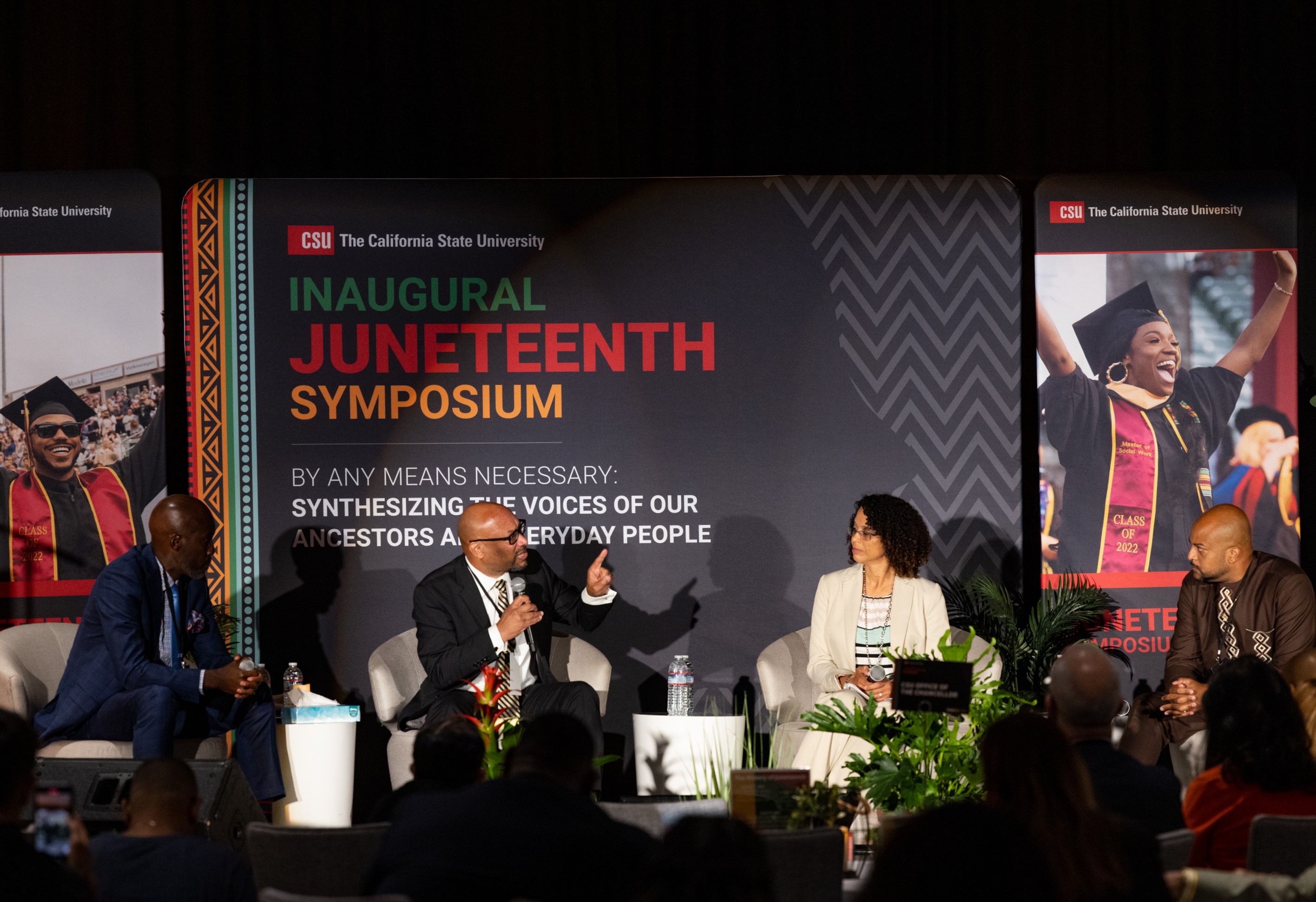
A panel discussion with University of California, Los Angeles Professor of Education Dr. Tyrone Howard, University of California Office of the President Provost and Executive Vice President for Academic Affairs Dr. Michael Brown, CSUDH Director of the Toro Reengagement Program Dr. Sabrina Sanders and Cosumnes River College President Dr. Edward Bush.
Developing Culturally Sensitive Faculty
The CSU promotes the highest standards of university teaching and fosters faculty professional growth and collaboration through CSU Innovative Teaching and Learning Programs (ITLP). Many of its initiatives are focused on improving equity in the classroom through culturally responsive pedagogy.
Additionally, the CSU announced the Creating Responsive, Equitable, Active Teaching and Engagement (CREATE) Awards program in June 2022, which aims to reinvigorate faculty commitment to the system's GI2025 efforts by increasing their sense of responsibility to each student's progress toward graduation.
CSU trustees also approved an ethnic studies and social justice general education requirement, which will go into effect for the 2023-24 academic year to allow time for faculty to develop plans and coursework that best meet the unique needs of their students and communities. CSU leaders say this amendment will help students become leaders in creating a more just and equitable society.
The CSU Chancellor's Doctoral Incentive Program prepares future faculty who are needed to teach the university's diverse student population. The program aims to recruit future faculty, mostly from among the university's own undergraduate and graduate programs and increase the representation of faculty of color.
Another way in which the CSU can improve equity on campuses is hiring more faculty, staff and administrators of color, and establishing support on campus to improve retention of those employees. San Diego State, for example, recently did a cluster hiring of people who demonstrate a focus on supporting specific student populations, such as Black students or Indigenous students, to promote a more inclusive, culturally competent faculty and staff who will better support the diverse students and communities served by SDSU. The campus is also home to 16 employee resource groups that serve 900 employees and are available to meet with prospective employees during the hiring process.
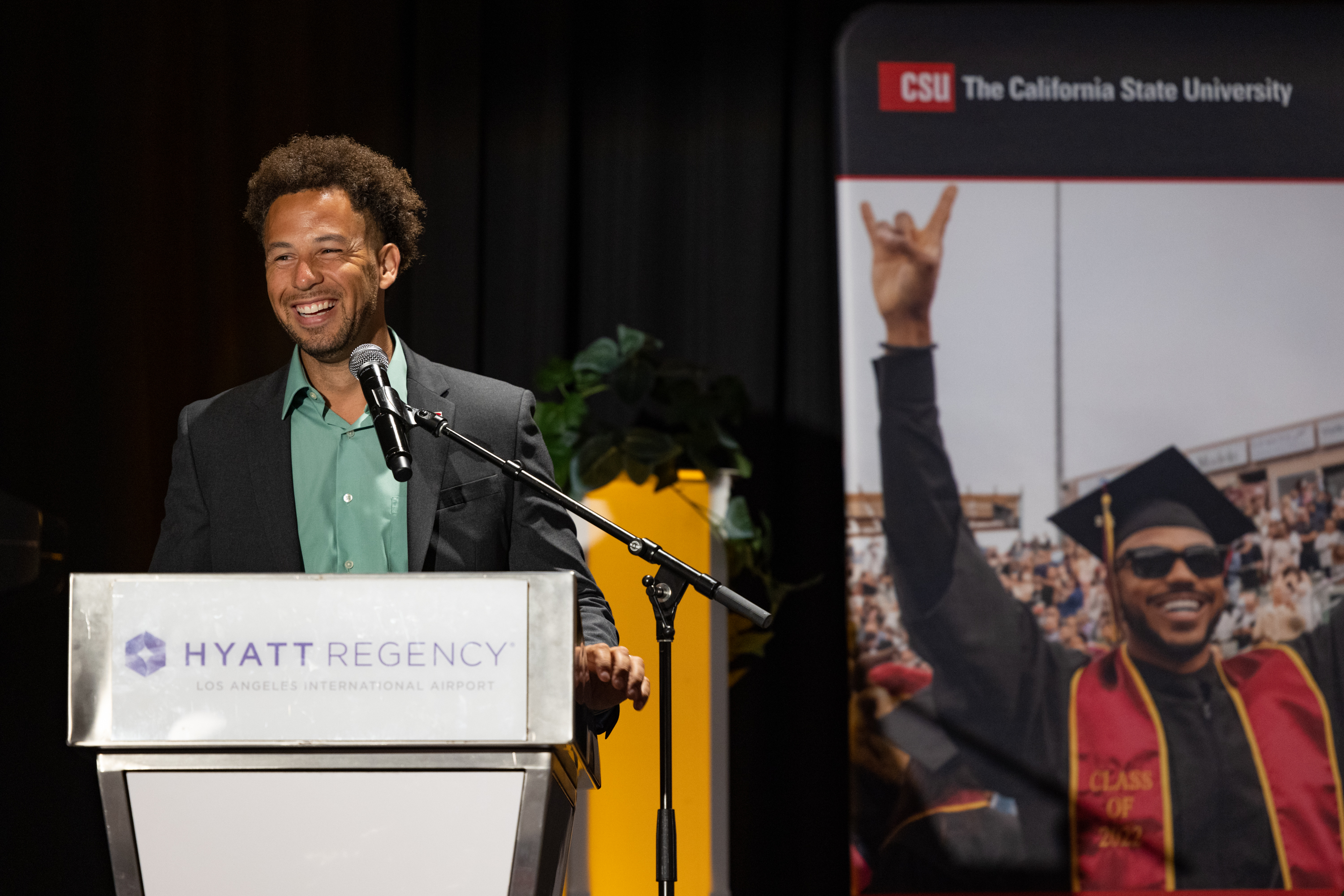
SDSU Vice President for Student Affairs and Campus Diversity/Chief Diversity Officer Dr. J. Luke Wood presents a keynote on "Racelighting," which Dr. Wood says occurs when a person of color begins to question their own reality because they are manipulated by others.
Improving the Pipeline
Research has found that students perform better when they can identify with their teachers and that teachers of color can play a key role in students' self-image of success. To that end, campuses are building a diverse educator workforce to increase representation in PK-12 education, especially in STEM fields. As the state's largest preparer of PK-12 teachers, the CSU can make a significant impact on equity in those classrooms by training more teachers of color.
The CSU also announced the creation of the CSU Center for Transformational Educator Preparation Programs (CSU CTEPP), which will leverage the successes of the New Generation of Educators Initiative (NGEI) with a focus on recruiting, preparing and retaining Black, Indigenous and other teachers of color to serve California's diverse students and families.
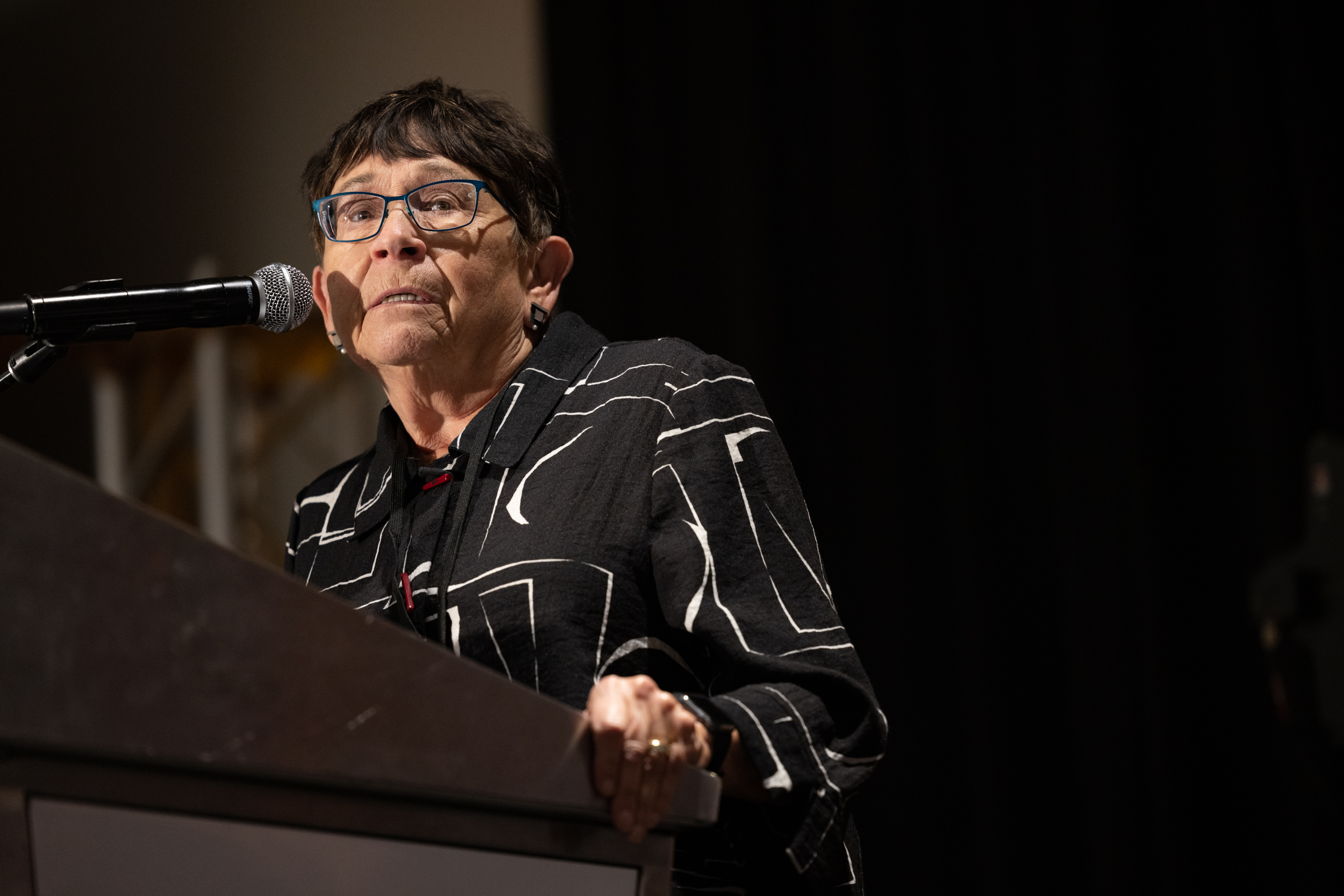
CSU Chancellor Koester closes out the symposium by underscoring the crucial need for systemic change to improve outcomes for Black and African American students.
Doubling Down
Despite these efforts, inequities continue to exist for Black and African American students in higher education, and Chancellor Koester leads the charge in committing to do more.
“Together we can—we must—summon the full power of education to ensure that every member of the Black and African American community has the abundant opportunity to live their dreams," Koester said. “We must start by ensuring that every CSU campus is a place of growth, support and belonging—a place that feels as natural as home."
Learn more about CSU campus efforts to improve educational equity for Black and African American students and see social media coverage of the symposium.